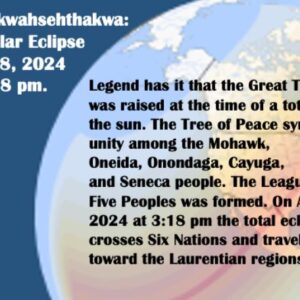
Tad McCallum
A unique political institution developed in colonial North America. The Covenant
Chain was an alliance or federation between British America, then principally New York, and the native peoples of the Great Lakes. Growing out of diplomatic protocols begun by the Dutch and the Mohicans, it was adopted by the British and Iroquois, later incorporating the western Algonquian peoples. The Iroquois saw it as an extension of their own federation that had been in existence since Pre-Columbian times. The guiding principles of its constituent members were respect for autonomy, non-interference, and mutual assistance.
The Covenant Chain existed from 1680 to 1750. In 1750 the colonial Government Partner was replaced by the British authorities as the British hoped to cultivate military alliances with the Natives for the struggle with France. Diplomacy and trade were also part of the mandate of their functionaries who were also known as The Indian Department. Later they became known as Butler’s Rangers and were loyalist partisans during the American War of Independence.
In the mid-18th century the Iroquois granted the Indian Department access to the salt deposit at the heart of their confederacy – Lake Onondaga. In return for this, the British promised the Iroquois peace with their neighbours, the Ojibwa. Peace with the Ojibwa was achieved by recognizing their sovereignty of Saguinan (Southern Ontario). This agreement was later formalized as the Royal Proclamation of 1763 and the Treaty of Niagara in 1764.
Salt was important as a dietary supplement, food preservative, and antiseptic. It is vital to life. As blood is saline there is cultural significance; the sharing of salt has familial associations.
Native Sovereignty of the lands west of the thirteen colonies was recognized in the Royal Proclamation of 1763. This was a cause of the American War of Independence as the Americans had expansionary aspirations. Indian Sovereignty of Southern Ontario was also recognized without reservation in a meeting with two thousand natives from 25 nations at Niagara in 1764 with the Treaty of Niagara.
American lust for native land was also a cause of the War of 1812. American War Hawks desired to conquer Canada as the British were arming Native peoples in the Old North West (the area south and west of the western Great Lakes). Prominent among the War Hawks was Peter B. Porter, land speculator, Quartermaster of the New York militia, and War Secretary. He had a military and commercial centre at Black Rock and controlled the Niagara Portage on the U.S. side. He had a near-monopoly on the flow of goods to the Ohio Valley, especially salt to the forts at Detroit and Michilimackinac.
Porter desired the evacuation of the Natives east of Mississippi. The conquest of Canada was also one of his goals. He coveted the real estate interests and the Forwarding Trade of Robert Hamilton on the Canadian side. According to Robert S. Allen in His Majesty’s Indian Allies (pp. 20) “The employment of native allies by the British Crown during the War of 1812 was the single most important factor in the defence of Upper Canada.” There were ten thousand natives engaged in the defence of Canada: 1,590 from Canada and 8,410 from the Western Nations. According to James Laxer, “They were indispensible”.
The following tribes were engaged in the defence of Canada: The Ojibwa and Dakota at Michilimackinac; The Ojibwa, Odawa, Potawatomi, and Shawnee at Detroit; The Iroquois and Delaware at Queenston Heights; The Iroquois with Ojibwa and Mississaugas at Beaver Dams; and The Algonquin, Mohawk, Huron, and Abenaki at Chateauguay.
Many battles in the Ohio Valley were won with Western Nation assistance.
To the native people the natural landscape was considered a manifestation of spiritual and metaphysical reality. The Native Manitou Missikenebec (the horned serpent) represents the link between the living and the dead. Fearsomely destructive, it is considered the Protector of Waters. As a serpent discards its skin it depicts life out of death. The Niagara Escarpment and gorge were Missikenebec, a Spirit Path linking life and death. The Breaking of Waters at
Niagara represents the Source of Life. Its other Canadian terminus is Manitoulin Island, the place of the spirit or afterlife, considered auspicious for funerals. In Iroquois lore the curve of the Horse Shoe Falls is the coil of the horned serpent. In the environs of Craigleath there is a legendary sacred rock by the escarpment known to the Hurons as Ekarenniodi, the Companion of Souls.
In his intriguing look at native spirituality, Sacred Earth: The Spiritual Landscape of Native America, the scholar-mystic Arthur Versluis makes a number of insightful observations – that this world and the afterlife are profoundly interrelated and nature is the theatre in which the spiritual and human realms intersect.
There was a metaphysical dimension to the defence of Canada in the War of 1812. A number of key battles were fought in the environs of the Niagara Gorge and Escarpment (Spirit Path) close to the graves or recent deaths of significant individuals. At Queenston Heights the escarpment turns into the Niagara Gorge. The battle of Queenston Heights occurred in mid-October of 1812. A founder of Upper Canada, Robert Hamilton, is buried close to the base of the Heights. Hamilton was the sutler or quartermaster of the Indian Department and British army and was active in the forwarding trade. His operations lent themselves to the establishment of a fundamental infrastructure for Upper Canada. He was also a magistrate.
In the preliminary attempt to dislodge the Americans from the Heights, Brock and MacDonnell were killed by gunfire. Brock was a guarantor of native nationhood, and the administrator and military commander of Upper Canada. MacDonnell, in his youth, had been a commander of Butler’s Rangers and was later a member and speaker of the Legislature. The Battle of Stony Creek was fought under the shadow of the escarpment adjacent to a graveyard. A score of the earliest grave markers are no longer extant but as so many of the early settlers were Butler’s Rangers or members of the Indian Department it is reasonable to assume that they were among them. The victor of the battle, Lt. Colonel J. Harvey, has a memorial here. Perhaps this is a subliminal salute to the role of the dead. Indeed the memorial is often confused for a grave.
In Feng Shui, the Chinese art of the spirituality of the place, earth energy is conceived of as a Dragon or Serpent. A peninsula is considered the head of the serpent. Drummond Hill, the highest point on the Niagara Peninsula, was the site of the battle of Lundy’s Lane and is the Horn of the Serpent (Missikenebec), a place of power. At the battle of Lundy’s Lane the allied British, Canadian, and native position was a graveyard.
The earliest recorded internment was that of J. Burch who was the sutler (de facto quartermaster) of Butler’s Rangers at Fort Niagara during the War of Independence. He was in charge of Indian Stores at the fort and fed starving Iroquois during American General Sullivan’s attempted ethnic cleansing. He was buried according to Iroquois traditions but was interred elsewhere, in Chippewa. His remains were moved to Drummond Hill 12 years after his death, when the flesh had fallen from his bones. A prominent internment in the cemetery a year and some days before the battle was Lt. Colonel Cecil Bisshopp. Bisshopp coordinated military activities among the allies. He was fatally wounded on July 11, 1813 while retrieving 123 barrels of salt during a raid on Peter B. Porter’s depot at Black Rock – the same salt which was the core of the Covenant between the British and the Natives guaranteeing Native Sovereignty. Porter was among the hapless American Forces invading at Lundy’s Lane. An epic battle resulted in an American retreat and an abandonment of any plans to conquer Canada.
Tecumseh and his warriors were deserted by the British under Procter at the Battle of the Thames, resulting in the brutal death of the great Shawnee Chief. The British also abandoned the natives at the negotiating table at Ghent. The British Banker Baring was instrumental in this with the assistance of his ally and agent Wellington. Baring was a leading investor in the United States and made millions by purchasing the Louisiana Territory from France and reselling it to the U.S. As a result the United States increased its territory by 140%. Baring was a major creditor of both the British and U.S. governments and was a supporter of free trade between the countries. He handled U.S. banking in Europe.
Wellington, who had enormous prestige and influence, prevailed upon Lord Liverpool, the Prime Minister, to betray Brock’s pledge of a Native Homeland in the Ohio Valley.
The shameful litany of Canada’s treatment of its native peoples is a national disgrace. The apartheid system racial segregation formerly instituted in South Africa was based on Canada’s reserve system. The Indian Act was a dictatorial imposition not a treaty. The Indian agent had the power of a magistrate – he could determine residence requirements, lifestyles, and the economics of land use. Government policies included coercion, deportation, and expropriation. Inadequate funding for housing, policing, and education are continuing problems. The mandatory residential school system in which cultural and linguistic genocide was perpetrated and abuse commonplace resulted in inter-generational trauma the effects of which continue to be felt.
Native peoples on reserves have very high rates of water contamination and crowded housing. Natives have a lower level of life expectancy than the general population and much higher rates of diseases such as Tuberculosis and HIV.
Suicide rates are many times higher, as are the rates of incarceration. Natives have lower levels of income. Poverty and discrimination are commonplace.
In the nineteenth century some ceremonial dances and the Pot Loch ceremony were banned. Pot Loch, a gift giving ceremony threatened the newcomers’ ethos of greed and acquisitiveness.
In 1924 the Federal Government used the RCMP to usurp the traditional government of Iroquois at Ohsweken. Wampum belts, native legal instruments that guaranteed their autonomy and legal status, were seized. Between 1927 and 1951 it was illegal for a lawyer to advance a native land claim.
Paternalistic and assimilationist attitudes continue. The rust must be removed from the Covenant Chain and the chain brightened again following the principle of equality of civilizations leading to partnership and mutual benefit.







